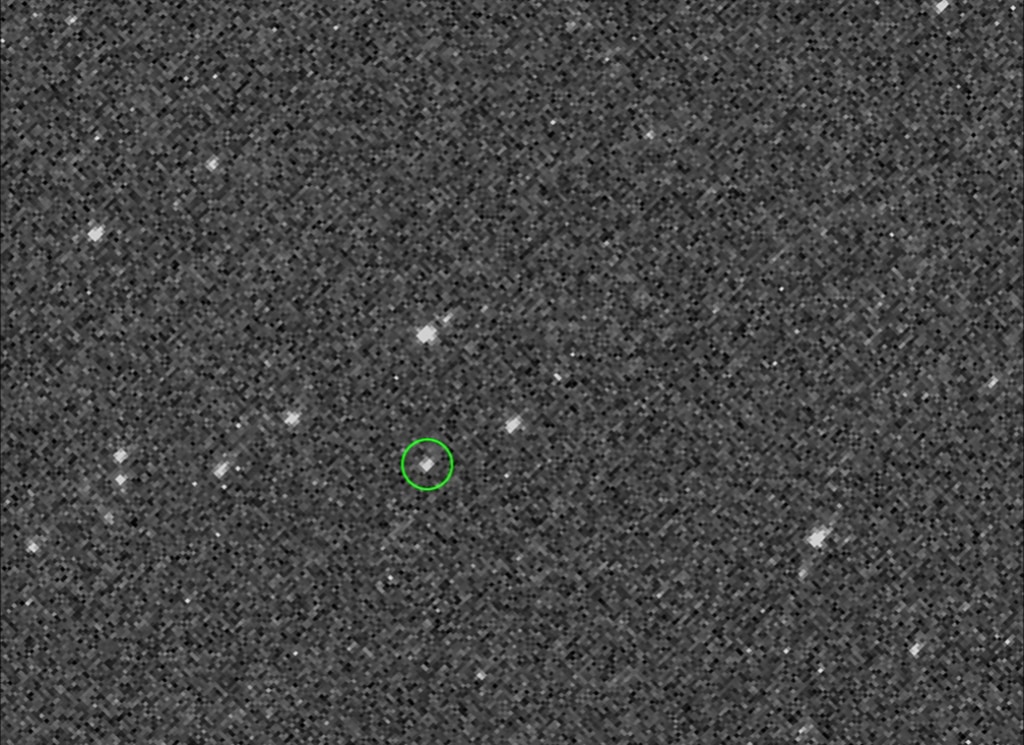
NASA's asteroid-sampling OSIRIS-REx probe is shifting out of pure chase mode.
OSIRIS-REx, which launched toward the 1,640-foot-wide (500 meters) near-Earth asteroid Bennu in September 2016, begins studying the space rock from afar today (Sept. 11), mission team members announced.
"Big day for @OSIRISREx — we start our first science observations — searching for dust plumes around Bennu," mission principal investigator Dante Lauretta, a professor of planetary science and cosmochemistry at the University of Arizona's Lunar and Planetary Laboratory, said via Twitter today. [OSIRIS-REx: NASA's Asteroid Sample-Return Mission in Pictures]
A better understanding of Bennu's dust environment will help keep OSIRIS-REx safe as it approaches the asteroid later this year, NASA officials have said. The spacecraft is scheduled to reach Bennu on Dec. 3 and slide into orbit around the space rock four weeks later, on Dec. 31.
OSIRIS-REx — whose name is short for "Origins, Spectral Interpretation, Resource Identification, Security - Regolith Explorer" — will continue studying Bennu for a while from orbit. Then, in mid-2020, it will cruise down to the asteroid's surface and grab a sample of material, which will come back to Earth in a special return capsule in September 2023.
Scientists around the world will pore over this cosmic dirt and gravel, hunting for clues about the solar system's early days and the role that carbon-rich asteroids like Bennu may have played in delivering water and the chemical building blocks of life to Earth.
The sample will also likely be of interest to asteroid miners, as it's expected to reveal details about the resource potential of Bennu and other space rocks like it, mission team members have said.
Get the Space.com Newsletter
Breaking space news, the latest updates on rocket launches, skywatching events and more!
The $800 million OSIRIS-REx mission will also contribute to planetary-defense efforts. For example, the probe's observations should help researchers better understand the forces that shape potentially dangerous asteroids' paths through space, Lauretta said during a NASA news conference last month. (Bennu itself is potentially hazardous; there's a very small chance that it could hit Earth in the late 22nd century.)
OSIRIS-REx isn't the only asteroid-sampling spacecraft that's active right now. Japan's Hayabusa2 probe arrived at its target, the big asteroid Ryugu, this summer and is currently practicing for its first touchdown maneuver, which is scheduled to take place next month.
Follow Mike Wall on Twitter @michaeldwall and Google+. Follow us @Spacedotcom, Facebook or Google+. Originally published on Space.com.
Join our Space Forums to keep talking space on the latest missions, night sky and more! And if you have a news tip, correction or comment, let us know at: community@space.com.

Michael Wall is a Senior Space Writer with Space.com and joined the team in 2010. He primarily covers exoplanets, spaceflight and military space, but has been known to dabble in the space art beat. His book about the search for alien life, "Out There," was published on Nov. 13, 2018. Before becoming a science writer, Michael worked as a herpetologist and wildlife biologist. He has a Ph.D. in evolutionary biology from the University of Sydney, Australia, a bachelor's degree from the University of Arizona, and a graduate certificate in science writing from the University of California, Santa Cruz. To find out what his latest project is, you can follow Michael on Twitter.









